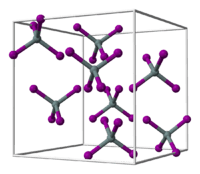Zirconium(IV) bromide
 | |
| Names | |
|---|---|
| Other names
zirconium tetrabromide | |
| Identifiers | |
| 13777-25-8 | |
| 3D model (Jmol) | Interactive image |
| ChemSpider | 75549 |
| ECHA InfoCard | 100.034.002 |
| |
| |
| Properties | |
| ZrBr4 | |
| Molar mass | 410.86 g/mol |
| Appearance | off-white powder |
| Density | 4.201 g/cm3, solid |
| Melting point | 450 °C (842 °F; 723 K) |
| Boiling point | sublimes |
| reacts with water | |
| Structure | |
| Cubic, cP40 | |
| P-43m, No. 205 | |
| Hazards | |
| EU classification (DSD) |
not listed |
| NFPA 704 | |
| Related compounds | |
| Other anions |
Zirconium(IV) fluoride Zirconium(IV) chloride Zirconium(IV) iodide |
| Other cations |
Titanium tetrabromide Hafnium tetrabromide |
| Except where otherwise noted, data are given for materials in their standard state (at 25 °C [77 °F], 100 kPa). | |
| | |
| Infobox references | |
Zirconium(IV) bromide is the inorganic compound with the formula ZrBr4. This colourless solid is the principal precursor to other Zr–Br compounds.
Preparation and properties
ZrBr4 is prepared by the action of bromine on zirconium oxide via a carbothermic reaction:[1]
- ZrO2 + 2 C + 2 Br2 → ZrBr4 + 2 CO
Like many related tetrahalides, it is purified by sublimation.
Like related tetrabromides of Ti and Hf, ZrBr4 hydrolyzes readily to give oxy-bromide, with release of hydrogen bromide.
Structure
ZrBr4 adopts the structure seen for the related compounds, TiCl4 and TiBr4, featuring tetrahedral Zr centers. In contrast, ZrCl4 is polymeric in the solid state, featuring octahedral Zr centers.[2]
References
- ↑ R. C. Young, Hewitt G. Fletcher, "Anhydrous Zirconium Tetrabromide" Inorganic Syntheses, 1939, vol. 1, pp. 49–51. doi:10.1002/9780470132326.ch18
- ↑ Wells, A.F. (1984) Structural Inorganic Chemistry, Oxford: Clarendon Press. ISBN 0-19-855370-6.
This article is issued from Wikipedia - version of the 6/21/2016. The text is available under the Creative Commons Attribution/Share Alike but additional terms may apply for the media files.
